9 Best Herbal Teas For Leg Pain
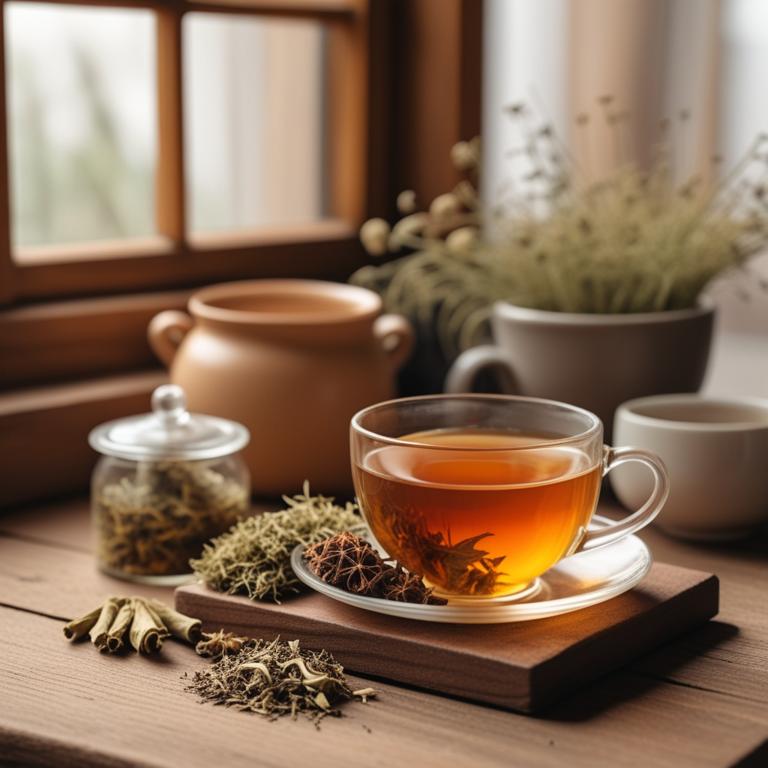
Herbal teas for leg pain are a blend of natural remedies used to alleviate discomfort, inflammation, and stiffness associated with leg pain.
These teas are effective in treating leg pain due to their anti-inflammatory, antioxidant, and analgesic properties, which help to reduce swelling, relax muscles, and soothe the pain.
Examples of herbal teas that can treat leg pain include ginger tea, which reduces inflammation and eases pain; turmeric tea, which contains curcumin that has potent anti-inflammatory properties; willow bark tea, which contains salicin that acts as a natural pain reliever; rosemary tea, which improves circulation and reduces muscle spasms; dandelion tea, which reduces inflammation and promotes relaxation; and ginseng tea, which improves circulation and reduces pain.
By incorporating these herbal teas into one's daily routine, individuals can experience relief from leg pain and enjoy a more comfortable and active lifestyle.
Related Study
According to the study, teas for leg pain, such as green tea, may be an effective treatment due to its antinociceptive effects and antioxidant and anti-inflammatory properties, particularly attributed to Epigallocatechin-3-gallate (EGCG).
Below there's a list of the 9 best herbal teas for leg pain.
Table of Contents
Also, you may be interested in...
Today Free Bonus!
The Ultimate Herb Drying Checklist
(For Long-Lasting Powerful Medicinal Effect)
How to easily dry herbs that don't mold and that keep their strong medicinal power for more than 1 year.
1. Ginkgo biloba teas
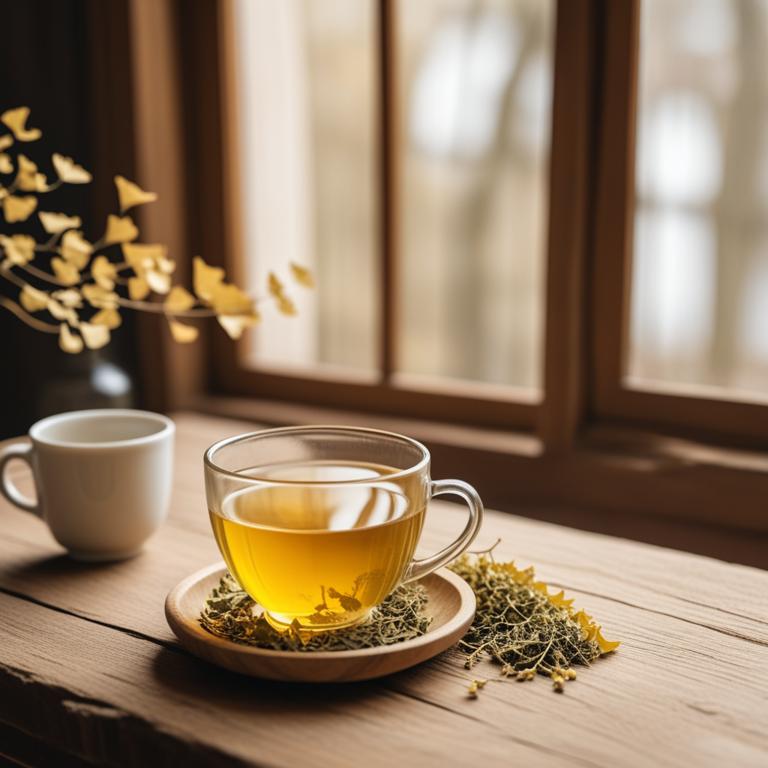
Ginkgo biloba teas have been traditionally used to treat leg pain ailments, such as peripheral arterial disease and intermittent claudication, due to their anti-inflammatory and antioxidant properties.
The flavonoids and terpenoids present in ginkgo biloba, including quercetin and bilobalide, help to improve blood circulation and reduce inflammation in the affected areas, thereby alleviating leg pain.
The bioactive constituents of ginkgo biloba teas, particularly the flavonoids and bilobalide, have been shown to inhibit platelet aggregation and improve nitric oxide production, leading to increased blood flow and oxygen delivery to the muscles.
Regular consumption of ginkgo biloba teas has been found to provide relief from leg pain and improve mobility in individuals suffering from peripheral arterial disease and intermittent claudication.
Related Study
According to "Presse medicale (Paris, France : 1983)", Ginkgo biloba teas for leg pain showed significant pain relief and improved walking tolerance in patients with arteritis after 6 months of treatment.
Recipe:
- Gather 1 cup of fresh or dried Ginkgo biloba leaves.
- Heat 1 cup of water in a pot and bring to a boil.
- Add 2-3 teaspoons of Ginkgo biloba leaves to the boiling water.
- Reduce heat and let it simmer for 5-10 minutes.
- Strain the tea and drink 1 cup, 2-3 times a day for leg pain relief.
Ginkgo biloba teas can be used to treat leg pain, but possible side effects may include dizziness, nausea, and stomach upset due to its blood-thinning properties, which may also increase the risk of bleeding.
Precautions should be taken when using Ginkgo biloba teas, such as avoiding it before surgery or with anticoagulant medications, and being cautious when engaging in activities that may cause injury, especially those involving heavy lifting or bending.
Ginkgo Biloba Tea on Amazon
Tai Chi Think Sharp Energizing Tea (Ginseng Ginkgo Biloba) 12 Bags
Disclaimer: We earn a commission if you click this link and make a purchase at no additional cost to you.
2. Zingiber officinale teas

Zingiber officinale teas, also known as ginger teas, have been traditionally used to treat leg pain, particularly in cases of arthritis and inflammation.
The anti-inflammatory and analgesic properties of ginger teas help to reduce pain and inflammation in the legs by inhibiting the production of pro-inflammatory enzymes and cytokines.
The bioactive constituents of ginger teas, including gingerols and shogaols, have been shown to contribute to their analgesic and anti-inflammatory effects.
Regular consumption of ginger teas has been found to provide relief from leg pain and promote overall well-being by reducing inflammation and improving circulation.
Related Study
According to "Arthritis and rheumatism", Zingiber officinale teas may be effective in reducing symptoms of osteoarthritis in the knee, including leg pain, with a moderate effect.
Recipe:
- Gather 1 tablespoon of fresh ginger root and 1 cup of boiling water.
- Peel the ginger root and slice it thinly.
- Add the sliced ginger to the boiling water and let it steep for 5-7 minutes.
- Strain the ginger from the water and add honey to taste, if desired.
- Drink the ginger tea hot or let it cool, then drink as needed for leg pain relief.
Zingiber officinale teas can be used to treat leg pain due to its anti-inflammatory properties, but consuming large amounts or using it for extended periods may lead to side effects such as stomach upset, nausea, and diarrhea.
To use Zingiber officinale teas safely, it's recommended to start with a small dose, gradually increasing it as needed, and to avoid consuming it on an empty stomach or with other medications that may interact with its active compounds.
Zingiber Officinale Tea on Amazon
FGO Organic Ginger Tea, 100 Count, Eco-Conscious Tea Bags, Caffeine Free, Packaging May Vary (Pack of 1)
Disclaimer: We earn a commission if you click this link and make a purchase at no additional cost to you.
3. Glycyrrhiza glabra teas

Glycyrrhiza glabra teas have been traditionally used to treat leg pain ailments, such as sciatica and lower back pain, due to their anti-inflammatory and antioxidant properties.
The bioactive constituents, including glycyrrhizin, flavonoids, and phenolic acids, help to reduce inflammation, relax muscles, and improve blood circulation, thereby alleviating pain and discomfort.
The anti-inflammatory properties of Glycyrrhiza glabra teas help to reduce swelling and pain in the affected areas, while the antioxidant properties protect against oxidative stress and promote overall well-being.
Regular consumption of Glycyrrhiza glabra teas has been shown to provide relief from leg pain and improve the quality of life for individuals suffering from these ailments.
Related Study
According to "Phytotherapy research : PTR", Glycyrrhiza glabra teas, as part of Glycyrrhizae Radix et Rhizoma, have been associated with significant reductions in hand-foot syndrome incidence, a condition that can manifest as leg pain in some patients, although further research is needed to confirm its efficacy for this specific symptom.
Recipe:
- Gather 2 tablespoons of dried Glycyrrhiza glabra root, a cup of boiling water, and a cup for serving.
- Measure 2 tablespoons of dried Glycyrrhiza glabra root into a tea infuser or a heat-resistant cup.
- Pour boiling water over the Glycyrrhiza glabra root in the tea infuser or cup.
- Steep the mixture for 5-7 minutes, then strain the liquid into another cup using a strainer or the tea infuser.
- Drink 1 cup of the tea 2-3 times a day for leg pain relief.
Glycyrrhiza glabra teas can be used to treat leg pain, but possible side effects may include increased blood pressure, potassium loss, and an irregular heartbeat in some individuals due to its potential to interact with other medications or worsen underlying conditions.
To use this herbal preparation safely, it's essential to monitor your blood pressure and potassium levels, avoid excessive consumption, and consider reducing or avoiding concurrent use with other medications, particularly those affecting blood pressure or heart function.
Glycyrrhiza Glabra Tea on Amazon
Pukka Herbal Teas Licorice and Cinnamon - 20 Bags, 20 Count
Disclaimer: We earn a commission if you click this link and make a purchase at no additional cost to you.
4. Curcuma longa teas
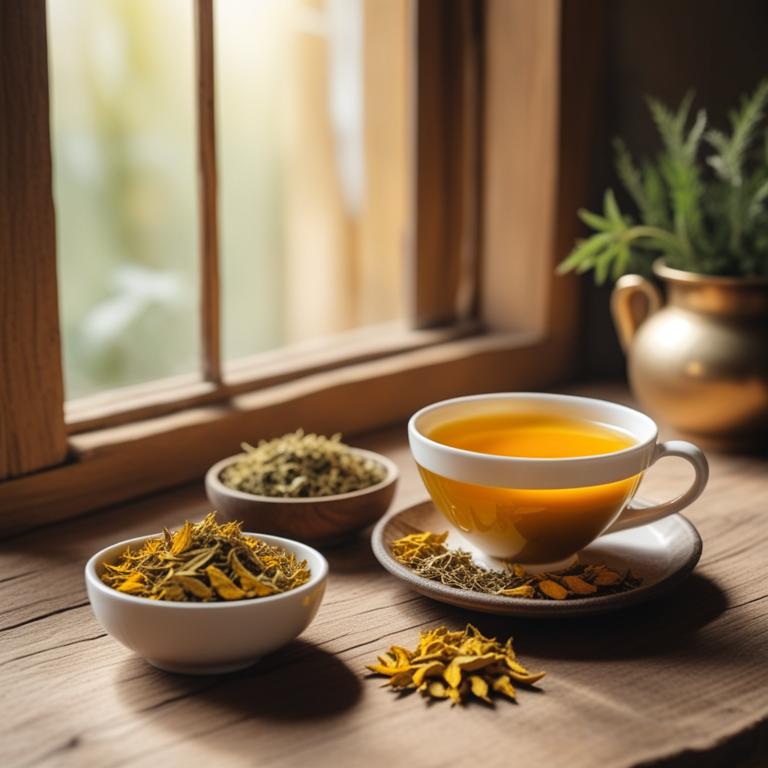
Curcuma longa teas have been traditionally used to treat leg pain, a common symptom of various ailments such as arthritis and sciatica.
The anti-inflammatory and analgesic properties of Curcuma longa teas help to reduce pain and inflammation in the affected areas.
The bioactive constituents, including curcumin, demethoxycurcumin, and bisdemethoxycurcumin, exhibit potent anti-inflammatory and antioxidant activities, which contribute to the relief of leg pain.
Drinking Curcuma longa teas regularly can help alleviate leg pain by reducing inflammation, improving circulation, and promoting relaxation, making it a beneficial herbal remedy for those suffering from leg pain.
Related Study
According to "Journal of medicinal food", Curcuma longa teas (containing Turmeric extracts) have been shown to be effective in reducing leg pain by reducing inflammation and pain levels, particularly at night and in specific positions.
Recipe:
- Gather 1 cup of water and 1/2 teaspoon of turmeric root powder (Curcuma longa) in a saucepan.
- Heat the water over medium heat until it starts to boil.
- Reduce heat to low and add 1/2 teaspoon of turmeric root powder to the boiling water.
- Let the mixture simmer for 5-7 minutes, then strain it into a cup.
- Add honey or lemon to taste, if desired, and drink the tea 2-3 times a day for leg pain relief.
Curcuma longa teas can be an effective treatment for leg pain, but it may also cause side effects such as stomach upset, diarrhea, and nausea due to its high curcumin content, which can irritate the digestive system.
To minimize potential side effects, individuals should start with a low dose and gradually increase it, also avoiding taking it on an empty stomach and combining it with food rich in healthy fats to enhance absorption.
Curcuma Longa Tea on Amazon
Pure Ceylon Turmeric Brew - 100% Organic Ceylon Turmeric Tea Bags (40 Sachets - pack of 2 – 20 COUNT PER BOX)
Disclaimer: We earn a commission if you click this link and make a purchase at no additional cost to you.
5. Valeriana officinalis teas
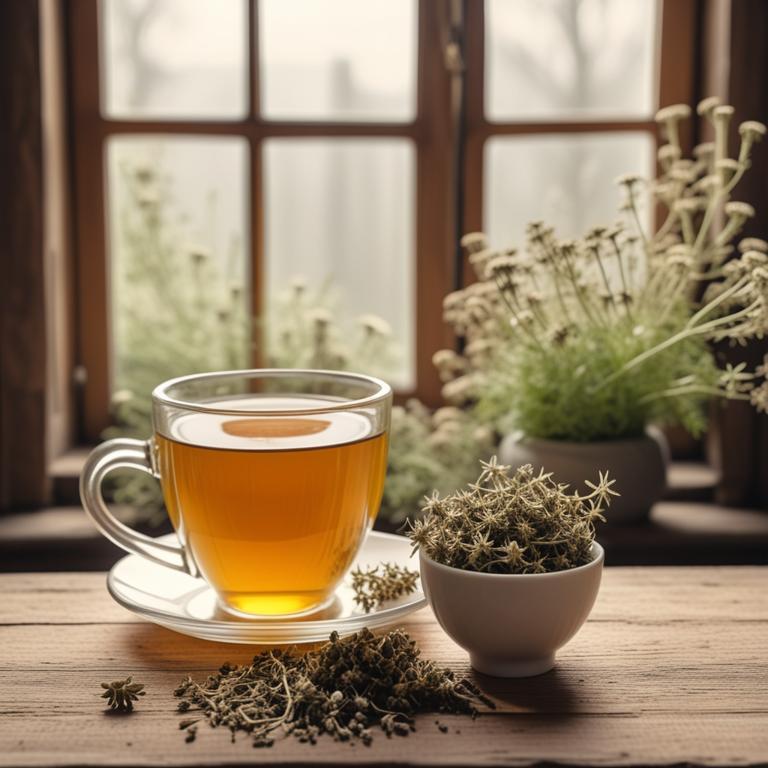
Valeriana officinalis teas have been traditionally used to treat leg pain ailments, such as muscle cramps, spasms, and inflammation, due to their analgesic, anti-inflammatory, and sedative properties.
The bioactive constituents of Valeriana officinalis, including valepotriates, valerenic acid, and isovaltrate, help to reduce muscle spasms, relax the muscles, and decrease pain perception.
By reducing muscle tension and inflammation, Valeriana officinalis teas help to alleviate leg pain and promote relaxation, making them a popular natural remedy for treating this ailment.
The benefits of using Valeriana officinalis teas to treat leg pain include reduced muscle spasms, improved sleep quality, and a decrease in pain intensity, making it a valuable addition to a treatment plan.
Related Study
According to "World journal of plastic surgery", Valeriana officinalis teas for leg pain may provide relief by significantly decreasing pain scores in both acute and chronic phases, particularly when used in combination with turnip extract.
Recipe:
- Gather 1 cup of boiling water and 1 teaspoon of dried Valeriana officinalis roots.
- Measure 1 tablespoon of dried Valeriana officinalis roots and add it to a tea infuser or a heat-resistant cup.
- Pour the boiling water over the Valeriana officinalis roots and let it steep for 5-7 minutes.
- Strain the tea into a cup and discard the roots. Add honey or lemon to taste, if desired.
- Drink the tea 2-3 times a day to help with leg pain. Consult a doctor before using Valeriana officinalis for medicinal purposes.
Valeriana officinalis teas can be used to treat leg pain, but they may cause side effects such as drowsiness, headaches, and stomach upset in some individuals, particularly when consumed in large quantities or taken for extended periods.
To minimize potential side effects, it is recommended to use Valeriana officinalis teas in moderation, ideally in the evening, and to avoid driving or operating heavy machinery while under its influence.
Valeriana Officinalis Tea on Amazon
Frontier Co-op Cut and Sifted Valerian Root 1lb, Kosher - for Valerian Root Tea, DIY Supplement Capsules, Bedtime Formulas and Sleep Pillows
Disclaimer: We earn a commission if you click this link and make a purchase at no additional cost to you.
6. Achillea millefolium teas
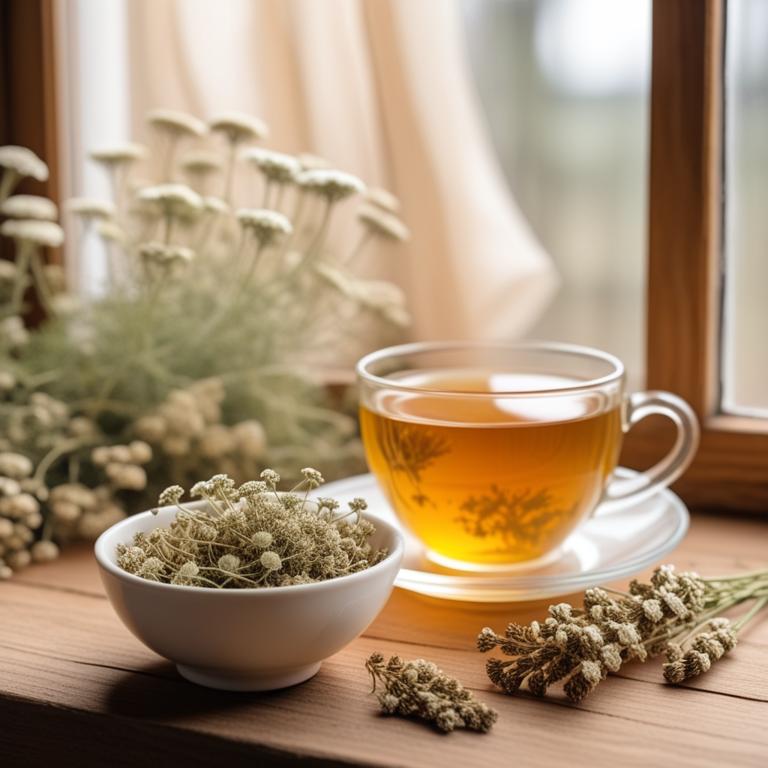
Achillea millefolium teas have been traditionally used to treat leg pain and related ailments, such as arthritis and joint inflammation, due to their anti-inflammatory and analgesic properties.
The bioactive constituents, including flavonoids, sesquiterpenes, and phenolic acids, in this herbal preparation help to reduce pain and inflammation by inhibiting the production of pro-inflammatory enzymes and cytokines.
By consuming Achillea millefolium teas, individuals can benefit from the reduction of pain and inflammation, improved joint mobility, and enhanced overall well-being.
The benefits of this herbal preparation in treating leg pain include reduced reliance on pain medication, improved quality of life, and a natural approach to managing chronic conditions.
Related Study
According to "Journal of ethnopharmacology", Achillea millefolium teas have been found to have beneficial effects in the treatment of wounds and potentially for leg pain, as it was one of the most commonly used medicinal plants in the Balkan region, with three laboratory studies and one clinical trial confirming its pharmacological characteristics.
Recipe:
- Gather 1 cup of fresh Achillea millefolium leaves or 2 tablespoons of dried leaves.
- Measure 1 cup of boiling water and pour it over the leaves in a heat-resistant cup.
- Let the mixture steep for 5-7 minutes to allow the herbs to infuse into the water.
- Strain the liquid into another cup using a cheesecloth or a fine-mesh sieve to remove the leaves.
- Drink 1/2 cup of the tea 2-3 times a day to help relieve leg pain.
Achillea millefolium teas can be used to treat leg pain by reducing inflammation and relieving pain, but possible side effects may include allergic reactions, digestive issues, and interactions with blood thinners, which may increase the risk of bleeding.
When using this herbal preparation to treat leg pain, it is essential to take precautions such as monitoring blood sugar levels, as Achillea millefolium can affect blood sugar control, and avoiding it in large quantities, as excessive consumption may lead to sedation and dizziness.
Achillea Millefolium Tea on Amazon
Biokoma Pure and Organic Yarrow Dried Herb 30 Tea Bags 1.5oz In Resealable Moisture Proof Pouch, USDA Certified Organic - Herbal Tea, No Additives, No Preservatives, No GMO, Kosher
Disclaimer: We earn a commission if you click this link and make a purchase at no additional cost to you.
7. Lavandula angustifolia teas

Lavandula angustifolia teas have been traditionally used to treat leg pain, a common symptom of various conditions such as arthritis and fibromyalgia.
The anti-inflammatory properties of this herbal preparation, including the presence of bioactive constituents like linalool and linalyl acetate, help to reduce pain and inflammation in the affected areas.
By promoting relaxation and reducing muscle spasms, Lavandula angustifolia teas help to alleviate leg pain and improve overall comfort.
The benefits of using Lavandula angustifolia teas to treat leg pain include reduced pain and inflammation, improved sleep quality, and a decrease in anxiety and stress levels.
Recipe:
- Get 1 tablespoon of dried Lavandula angustifolia flowers.
- Boil 1 cup of water in a pot.
- Pour the boiling water over the flowers in a cup.
- Let it steep for 5-7 minutes, then strain the tea.
- Drink 1 cup of the tea, 2-3 times a day, to help with leg pain.
Lavandula angustifolia teas can be used to treat leg pain, but possible side effects may include digestive issues, allergic reactions, and interactions with medications such as blood thinners, which can increase the risk of bleeding.
Precautions should be taken when using Lavandula angustifolia teas, such as starting with a low dose, avoiding use during pregnancy and breastfeeding, and monitoring for signs of liver damage, as excessive consumption can lead to liver issues.
Lavandula Angustifolia Tea on Amazon
Tiesta Tea - Lavender Chamomile Herbal Tea | Loose Leaf | Calming Blend with Chamomile and Lavender | Caffeine-Free Herbal | Great for Hot or Iced Brews | Resealable Bulk Pouch, 200 Cups | 8 Ounce
Disclaimer: We earn a commission if you click this link and make a purchase at no additional cost to you.
8. Camellia sinensis teas
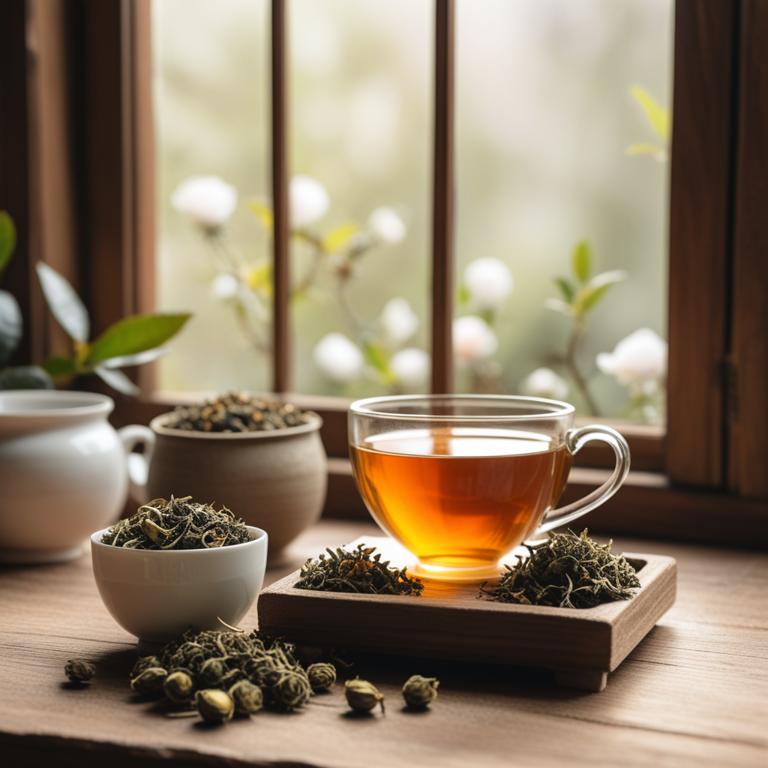
Camellia sinensis teas, which include green, black, and white tea, have been traditionally used to alleviate leg pain due to their anti-inflammatory and analgesic properties.
The bioactive constituents of Camellia sinensis, such as flavonoids and catechins, help to reduce inflammation and pain by inhibiting the production of pro-inflammatory enzymes and blocking the action of pain receptors.
These herbal preparations work by relaxing tense muscles, improving circulation, and reducing oxidative stress, which in turn helps to alleviate leg pain and discomfort.
The benefits of using Camellia sinensis teas to treat leg pain include reduced inflammation, improved joint mobility, and enhanced overall well-being, making them a popular natural remedy for this common ailment.
Recipe:
- Gather 1 teaspoon of loose-leaf Camellia sinensis tea and 1 cup of boiling water.
- Steep the tea in boiling water for 3-5 minutes.
- Strain the tea into a cup to remove loose leaves.
- Add honey or lemon to taste, if desired.
- Drink 1-2 cups of tea per day, as needed, to help manage leg pain.
Camellia sinensis teas can be used to treat leg pain due to its anti-inflammatory properties, but possible side effects may include dizziness, stomach upset, and interactions with certain medications, such as blood thinners and diabetes medications.
Precautions when using Camellia sinensis teas to treat leg pain include avoiding consumption in large quantities, limiting the duration of use, and being cautious when combining it with other herbal preparations or medications.
Camellia Sinensis Tea on Amazon
Ito En Traditional Matcha Green Tea 50 Count Zero Calories, Caffeinated
Disclaimer: We earn a commission if you click this link and make a purchase at no additional cost to you.
9. Rosmarinus officinalis teas
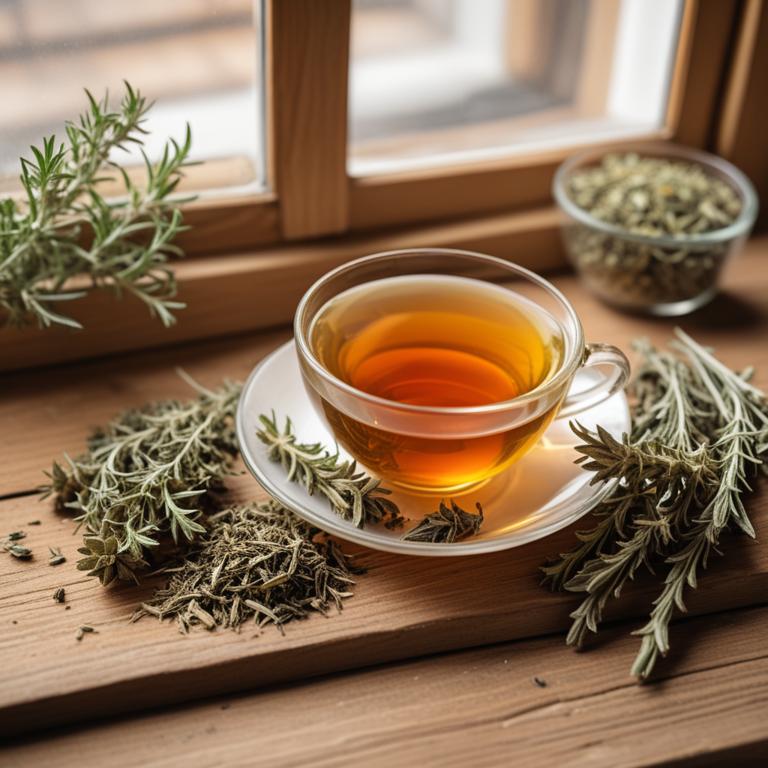
Rosmarinus officinalis teas have been traditionally used to treat leg pain ailments, such as sciatica and arthritis, due to their analgesic and anti-inflammatory properties.
The herbal preparation helps to treat leg pain by reducing inflammation and relieving pain through the inhibition of pro-inflammatory enzymes and mediators.
The bioactive constituents of Rosmarinus officinalis teas, including carnosic acid, rosmarinic acid, and camphor, contribute to its therapeutic effects by acting as antioxidants and anti-inflammatory agents.
The benefits of using Rosmarinus officinalis teas to treat leg pain include reduced pain and inflammation, improved mobility, and enhanced overall well-being.
Recipe:
- Gather 1 cup of fresh or dried Rosmarinus officinalis leaves.
- Add 1 tablespoon of Rosmarinus officinalis leaves to 1 cup of boiling water.
- Reduce heat and let it simmer for 5-7 minutes.
- Strain the mixture and discard the leaves.
- Drink 1 cup of the tea 2-3 times a day for leg pain relief.
Rosmarinus officinalis teas can be used to treat leg pain, but may cause side effects such as dizziness, nausea, and allergic reactions in some individuals, particularly those with sensitive skin or allergies to the plant.
To use Rosmarinus officinalis teas safely, take the recommended dosage, avoid consuming it with other herbal remedies or medications, and be cautious when driving or operating heavy machinery due to the potential for dizziness and lightheadedness.
Rosmarinus Officinalis Tea on Amazon
Palm Beach Medicinal Herbs - Rosemary Tea - Pure Herbal Tea Series, 30ct
Disclaimer: We earn a commission if you click this link and make a purchase at no additional cost to you.